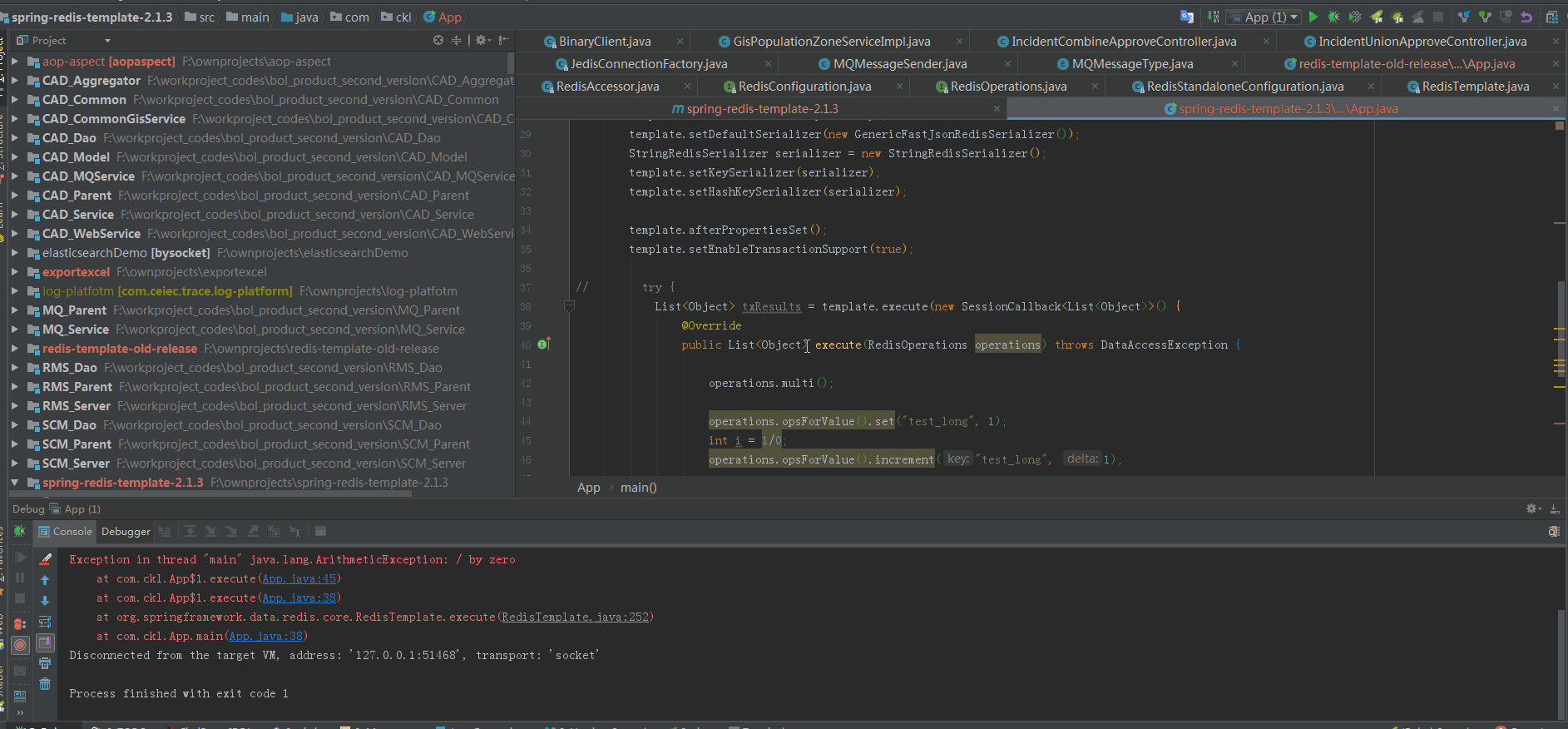spring-data-redis的事务操作深度解析--原来客户端库还可以攒够了事务命令再发?
一、官方文档
简单介绍下redis的几个事务命令:
redis事务四大指令: MULTI、EXEC、DISCARD、WATCH。
这四个指令构成了redis事务处理的基础。
1.MULTI用来组装一个事务;
2.EXEC用来执行一个事务;
3.DISCARD用来取消一个事务;
4.WATCH类似于乐观锁机制里的版本号。
被WATCH的key如果在事务执行过程中被并发修改,则事务失败。需要重试或取消。
以后单独介绍。
下面是最新版本的spring-data-redis(2.1.3)的官方手册。
https://docs.spring.io/spring-data/redis/docs/2.1.3.RELEASE/reference/html/#tx
这里,我们注意这么一句话:
Redis provides support for transactions through the
multi,exec, anddiscardcommands. These operations are available onRedisTemplate. However,RedisTemplateis not guaranteed to execute all operations in the transaction with the same connection.
意思是redis服务器通过multi,exec,discard提供事务支持。这些操作在RedisTemplate中已经实现。然而,RedisTemplate不保证在同一个连接中执行所有的这些一个事务中的操作。
另外一句话:
Spring Data Redis provides the
SessionCallbackinterface for use when multiple operations need to be performed with the sameconnection, such as when using Redis transactions. The following example uses themultimethod:
意思是:spring-data-redis也提供另外一种方式,这种方式可以保证多个操作(比如使用redis事务)可以在同一个连接中进行。示例如下:
//execute a transaction List<Object> txResults = redisTemplate.execute(new SessionCallback<List<Object>>() { public List<Object> execute(RedisOperations operations) throws DataAccessException { operations.multi(); operations.opsForSet().add("key", "value1"); // This will contain the results of all operations in the transaction return operations.exec(); } }); System.out.println("Number of items added to set: " + txResults.get(0));
二、实现事务的方式--RedisTemplate直接操作
在前言中我们说,通过RedisTemplate直接调用multi,exec,discard,不能保证在同一个连接中进行。
这几个操作都会调用RedisTemplate#execute(RedisCallback<T>, boolean),比如multi:
public void multi() { execute(connection -> { connection.multi(); return null; }, true); }
我们看看RedisTemplate的execute方法的源码:
1 public <T> T execute(RedisCallback<T> action, boolean exposeConnection, boolean pipeline) { 2 3 Assert.isTrue(initialized, "template not initialized; call afterPropertiesSet() before using it"); 4 Assert.notNull(action, "Callback object must not be null"); 5 6 RedisConnectionFactory factory = getRequiredConnectionFactory(); 7 RedisConnection conn = null; 8 try { 9 --开启了enableTransactionSupport选项,则会将获取到的连接绑定到当前线程 10 if (enableTransactionSupport) { 11 // only bind resources in case of potential transaction synchronization 12 conn = RedisConnectionUtils.bindConnection(factory, enableTransactionSupport); 13 } else {
-- 未开启,就会去获取新的连接 14 conn = RedisConnectionUtils.getConnection(factory); 15 } 16 17 boolean existingConnection = TransactionSynchronizationManager.hasResource(factory); 18 19 RedisConnection connToUse = preProcessConnection(conn, existingConnection);
。。。忽略无关代码。。。
26 RedisConnection connToExpose = (exposeConnection ? connToUse : createRedisConnectionProxy(connToUse)); 27 T result = action.doInRedis(connToExpose); -- 使用获取到的连接,执行定义在业务回调中的代码 28 。。。忽略无关代码。。。 33 34 // TODO: any other connection processing? 35 return postProcessResult(result, connToUse, existingConnection); 36 } finally { 37 RedisConnectionUtils.releaseConnection(conn, factory); 38 } 39 }
查看以上源码,我们发现,
- 不启用enableTransactionSupport,默认每次获取新连接,代码如下:
RedisTemplate<String, Object> template = new RedisTemplate<>(); template.multi(); template.opsForValue().set("test_long", 1); template.opsForValue().increment("test_long", 1); template.exec();
- 启用enableTransactionSupport,每次获取与当前线程绑定的连接,代码如下:
RedisTemplate<String, Object> template = new RedisTemplate<>(); template.setEnableTransactionSupport(true); template.multi(); template.opsForValue().set("test_long", 1); template.opsForValue().increment("test_long", 1); template.exec();
三、实现事务的方式--SessionCallback
采用这种方式,默认就会将所有操作放在同一个连接,因为在execute(SessionCallback<T> session)(注意,这里是重载函数,参数和上面不一样)源码中:
public <T> T execute(SessionCallback<T> session) {
Assert.isTrue(initialized, "template not initialized; call afterPropertiesSet() before using it");
Assert.notNull(session, "Callback object must not be null");
RedisConnectionFactory factory = getRequiredConnectionFactory();
//在执行业务回调前,手动进行了绑定
RedisConnectionUtils.bindConnection(factory, enableTransactionSupport);
try { // 业务回调
return session.execute(this);
} finally {
RedisConnectionUtils.unbindConnection(factory);
}
}
四、SessionCallback方式的示例代码:
1 RedisStandaloneConfiguration configuration = new RedisStandaloneConfiguration("192.168.19.90"); 2 JedisConnectionFactory factory = new JedisConnectionFactory(configuration); 3 factory.afterPropertiesSet(); 4 5 RedisTemplate<String, Object> template = new RedisTemplate<>(); 6 template.setConnectionFactory(factory); 7 template.setDefaultSerializer(new GenericFastJsonRedisSerializer()); 8 StringRedisSerializer serializer = new StringRedisSerializer(); 9 template.setKeySerializer(serializer); 10 template.setHashKeySerializer(serializer); 11 12 template.afterPropertiesSet(); 14 15 try { 16 List<Object> txResults = template.execute(new SessionCallback<List<Object>>() { 17 @Override 18 public List<Object> execute(RedisOperations operations) throws DataAccessException { 19 20 operations.multi(); 21 22 operations.opsForValue().set("test_long", 1); 23 int i = 1/0; 24 operations.opsForValue().increment("test_long", 1); 25 26 // This will contain the results of all ops in the transaction 27 return operations.exec(); 28 } 29 }); 30 31 } catch (Exception e) { 32 System.out.println("error"); 33 e.printStackTrace(); 34 }
有几个值得注意的点:
1、为什么加try catch
先说结论:只是为了防止调用的主线程失败。
因为事务里运行到23行,(int i = 1/0)时,会抛出异常。
但是在 template.execute(SessionCallback<T> session)中未对其进行捕获,只在finally块进行了连接释放。
所以会导致调用线程(这里是main线程)中断。

2.try-catch了,事务到底得到保证了没
我们来测试下,测试需要,省略非关键代码
2.1 事务执行过程,抛出异常的情况:
List<Object> txResults = template.execute(new SessionCallback<List<Object>>() {
@Override
public List<Object> execute(RedisOperations operations) throws DataAccessException {
operations.multi();
operations.opsForValue().set("test_long", 1);
int i = 1/0;
operations.opsForValue().increment("test_long", 1);
// This will contain the results of all ops in the transaction
return operations.exec();
}
});
执行上述代码,执行到int i = 1/0时,会抛出异常。我们需要检查,抛出异常后,是否发送了“discard”命令给redis 服务器?
下面是我的执行结果,从最后的抓包可以看到,是发送了discard命令的:

2.2 事务执行过程,不抛出异常的情况:
这次我们注释了抛错的那行,可以看到“EXEC”命令已经发出去了:

3 抛出异常,不捕获异常的情况:
有些同学可能比较奇怪,为啥网上那么多教程,都是没有捕获异常的,我这里要捕获呢?
其实我也奇怪,但在我目前测试来看,不捕获的话,执行线程就中断了,因为template.execute是同步执行的。
来,看看:

从上图可以看到,主线程被未捕获的异常给中断了,但是,查看网络抓包,发现“DISCARD”命令还是发出去了的。
4.总结
从上面可以看出来,不管捕获异常没,事务都能得到保证。只是不捕获异常,会导致主线程中断。
不保证所有版本如此,在我这,spring-data-redis 2.1.3是这样的。
我跟了n趟代码,发现:
1、在执行sessionCallBack中的代码时,我们一般会先执行multi命令。
multi命令的代码如下:
public void multi() { execute(connection -> { connection.multi(); return null; }, true); }
即调用了当前线程绑定的connection的multi方法。
进入JedisConnection的multi方法,可以看到:
private @Nullable Transaction transaction;
public void multi() { if (isQueueing()) { return; } try { if (isPipelined()) { getRequiredPipeline().multi(); return; }
//赋值给了connection的实例变量 this.transaction = jedis.multi(); } catch (Exception ex) { throw convertJedisAccessException(ex); } }
2、在有异常抛出时,直接进入finally块,会去关闭connection,当然,这里的关闭只是还回到连接池。
大概的逻辑如下:

3.在没有异常抛出时,执行exec,在exec中会先将状态变量修改,后边进入finally的时候,就不会发送discard命令了。

最后的结论就是:
所有这一切的前提是,共有同一个连接。(使用SessionCallBack的方式就能保证,总是共用同一个连接),否则multi用到的连接1里transcation是有值的,但是后面获取到的其他连接2,3,4,里面的transaction是空的,
还怎么保证事务呢?
五、思考
在不开启redisTemplate的enableTransactionSupport选项时,每执行一次redis操作,就会向服务器发送相应的命令。
但是,在开启了redisTemplate的enableTransactionSupport选项,或者使用SessionCallback方式时,会像下面这样发送命令:

后来,我在《redis实战》这本书里的4.4节,Redis事务这一节里,找到了答案:

归根到底呢,因为重用同一个连接,所以可以延迟发;如果每次都不一样的连接,只能马上发了。
这里另外说一句,不是所有客户端都这样,redis自带的redis-cli是不会延迟发送的。
六、源码
https://github.com/cctvckl/work_util/tree/master/spring-redis-template-2.1.3



 浙公网安备 33010602011771号
浙公网安备 33010602011771号